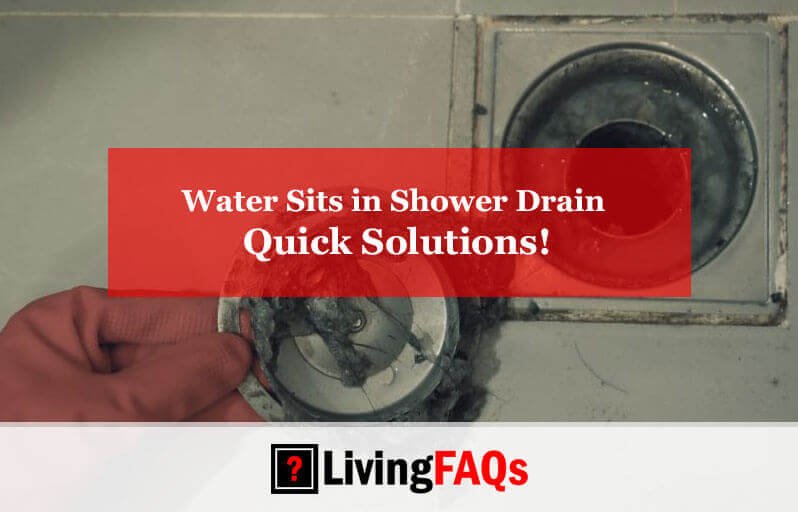Water sitting in a shower drain indicates a clog or slow drainage. Immediate attention is necessary to prevent water damage and mold growth.
Standing water in the shower can be a nuisance, often signaling a clogged drain that disrupts your daily routine. A blocked shower drain is typically caused by a buildup of hair, soap scum, and other debris. This can lead to slow water drainage, unpleasant odors, and even become a breeding ground for bacteria.
Addressing this issue promptly not only enhances your showering experience but also maintains the hygiene of your bathroom. Ensuring clear drains is crucial for household maintenance, and understanding the common causes of blockages can help prevent future occurrences. Regular cleaning and mindful practices can keep your shower drain free-flowing, offering peace of mind and a more enjoyable bathroom environment.
Introduction To Common Shower Drain Issues
Shower drains can be home to various issues. These problems often stem from clogs and blockages. Such issues can disrupt daily routines. Immediate attention is key to prevent further complications.
Symptoms Of Clogged Drains
Several signs indicate a clogged shower drain:
- Slow drainage – Water pools and drains slowly.
- Bad odors – Unpleasant smells emerge from the drain.
- Gurgling sounds – Noises occur when water is draining.
These symptoms suggest a blockage. Early detection can save time and money.
Impact On Daily Routine
Shower drain issues can affect daily life:
| Issue | Impact |
|---|---|
| Slow Drainage | Delays in shower use |
| Water Backup | Increased risk of slips and falls |
| Odors | Unpleasant bathroom environment |
A clogged drain can turn a shower into a hassle. Prompt fixing restores normalcy.
Initial Assessment Of The Problem
Water sitting in your shower drain can be a nuisance. It signals a blockage that needs immediate attention. The first step is assessing the problem properly.
Identifying The Type Of Blockage
Blockages can vary. Knowing the type helps choose the right fix.
- Hair – A common cause, often near the surface.
- Soap scum – Builds up over time, narrowing pipes.
- Mineral deposits – Hard water can leave residues.
- Foreign objects – Small items accidentally dropped down.
Use a flashlight to peek into the drain. It might show the blockage type.
Safety Precautions Before Diy Solutions
Ensure safety before attempting to fix the drain yourself.
- Wear gloves – Protects hands from dirt and germs.
- Turn off water – Prevents further flooding during the fix.
- Use correct tools – Plungers or drain snakes, not chemicals.
- Keep area ventilated – Fresh air is important if using any chemicals.
Following these steps helps prepare for a safe and effective DIY solution.
Simple Diy Fixes
Got water standing in your shower drain? Don’t worry! Here are some simple DIY fixes you can try at home.
Using A Plunger
Clearing a clogged drain might be easier than you think. A plunger can do the trick.
- Start with a dry shower.
- Place the plunger over the drain.
- Pump the plunger up and down vigorously.
- Flush with water to check if the clog is gone.
Repeat if necessary. Plungers can dislodge hidden blockages effectively.
Homemade Drain Cleaner Recipes
Chemical cleaners can be harsh. Natural solutions are safe and easy to make.
-
Baking Soda and Vinegar:
- Pour 1 cup baking soda down the drain.
- Follow with 1 cup white vinegar.
- Cover the drain and wait for 15 minutes.
- Rinse with boiling water.
-
Lemon and Salt:
- Mix 1 cup lemon juice with 1/2 cup salt.
- Pour the mixture down the drain.
- Let it sit for 30 minutes.
- Rinse with hot water.
These mixtures can cut through grease and grime, leaving drains clear and odor-free.

Credit: www.reddit.com
Natural Solutions To Try
Shower drains can sometimes hold water. This is not ideal. Blockages cause this issue. Natural methods can fix this without harsh chemicals. These solutions are safe and easy.
Baking Soda And Vinegar Method
Pour baking soda down the drain. Follow with vinegar. The mix will fizz. This fizzing action helps break down the clog. Wait for an hour. After waiting, flush with hot water. This method is eco-friendly.
Hot Water Flushing Technique
Boil water in a kettle. Carefully pour it down the drain. Hot water melts fats and soaps. These substances often cause clogs. Repeat if needed. This technique is simple and effective.
- Baking soda is a natural cleaner.
- Vinegar breaks down organic matter.
- Hot water clears soap and grease.
Chemical Drain Cleaners
Standing water in your shower can be a nuisance. Chemical drain cleaners offer a quick fix. These powerful solutions dissolve hair, grease, and other clogs. Yet, selecting and applying these cleaners needs care. This guide helps you use them safely and effectively.
Selecting The Right Product
Not all chemical drain cleaners are the same. They come in different types for various clogs. Read labels carefully to match the cleaner with your drain issue. For shower drains, look for cleaners designed to tackle hair and soap scum. Avoid products too harsh for your plumbing. Some can damage pipes over time.
- For hair clogs: Choose a cleaner with enzymes.
- For grease or soap: Pick a product with lye or sulfuric acid.
- For sensitive pipes: Opt for a gentler, eco-friendly option.
Application Tips For Maximum Effectiveness
Using chemical drain cleaners correctly maximizes their benefits while keeping your pipes safe. Here are key steps:
- Wear gloves and goggles to protect your skin and eyes.
- Follow the instructions on the product label closely.
- Apply the recommended amount. Using too much can harm your pipes.
- Wait the suggested time for the cleaner to work its magic.
- Flush with hot water to clear away the dissolving clog.
Remember, safety first. Never mix different cleaners. This can release dangerous gases.

Credit: m.youtube.com
Plumbing Tools For The Job
Experiencing water sitting in your shower drain can be frustrating. The right plumbing tools can make a big difference. This section explores essential tools to tackle this issue effectively.
Utilizing A Plumber’s Snake
A plumber’s snake is a handy tool. It helps remove blockages deep in the drain. The snake, a flexible metal cable, reaches clogs conventional tools can’t.
- Insert the snake into the drain until you meet resistance.
- Twist the handle to break up the clog.
- Continue feeding the snake further into the drain.
- Remove the snake and check for debris.
Repeat the process if needed. Always clean the tool after use.
When To Use A Drain Auger
A drain auger is another effective tool. It is similar to a plumber’s snake but more powerful. Use it for stubborn clogs that the snake can’t clear.
- Feed the auger cable into the drain slowly.
- Crank the handle to break up or retrieve the clog.
- Pull the cable back to remove debris.
The drain auger is ideal for deep, tough clogs. Always wear gloves and goggles for safety.
Preventive Measures
Stagnant water in a shower drain creates a perfect home for mold and unpleasant smells. Preventive measures are crucial to keep the water flowing freely. Let’s explore some effective strategies to maintain a clear and clean drain.
Regular Maintenance Tips
- Flush with hot water weekly to dissolve soap and oil.
- Use a homemade mixture of vinegar and baking soda monthly to break down debris.
- Check for clogs often and remove any visible obstructions.
- Seek professional help if DIY solutions fail to clear blockages.
Installing Drain Covers
Drain covers catch hair and other particles before they enter the drain. This simple tool can save you from major clogs.
- Choose a drain cover that fits your shower.
- Install it over the drain to trap debris.
- Clean the cover regularly to ensure it works effectively.
When To Call A Professional
Shower drains can clog and cause water to sit. This is a common problem in many homes. At times, simple DIY methods can fix it. Other times, you need a professional plumber to take a look. Knowing when to call in the experts is crucial for your plumbing health.
Recognizing Persistent Drain Issues
Recognizing Persistent Drain Issues
Water pools in your shower and drains slowly or not at all. This suggests a deep clog. Foul odors can indicate a more serious issue. If home remedies fail, it’s time to call a professional.
Finding a Reputable Plumber
Finding A Reputable Plumber
Start by asking friends for plumber recommendations. Online reviews on platforms like Yelp can also help. Look for plumbers with good ratings and positive feedback. Ensure they have the proper licenses and insurance.
- Check for plumbers with 24/7 services.
- Compare rates and response times.
- Ask about warranties on their work.
| Criteria | What to Look For |
|---|---|
| Licensing | Plumber’s valid license number |
| Experience | Years in business, types of jobs |
| Reviews | Positive feedback from customers |
| Insurance | Protection against accidents |
| Availability | Emergency services, open hours |

Credit: www.reddit.com
Frequently Asked Questions
Why Does Water Pool In My Shower Drain?
Standing water in a shower drain often results from clogs or blockages caused by hair, soap scum, or other debris accumulating over time.
Can A Clogged Vent Cause Shower Drain Issues?
Yes, a clogged vent pipe can hinder proper drainage by disrupting airflow, leading to water backup in your shower drain.
What Are Signs Of A Blocked Shower Drain?
Slow draining water, unpleasant odors, and gurgling sounds are common indicators of a shower drain being blocked.
How Do You Fix Water Retention In Shower Drains?
Clearing out any visible obstructions, using a plunger or a plumber’s snake, and occasionally, chemical drain cleaners can resolve water retention issues.
Is Standing Water In Shower Harmful?
Persistent standing water can lead to mold growth, unpleasant smells, and potential damage to bathroom fixtures if left unaddressed.
Conclusion
Dealing with water in your shower drain doesn’t have to be a hassle. Simple steps can prevent buildup and ensure smooth drainage. Regular cleaning, mindful practices, and timely repairs make all the difference. Embrace these habits, and say goodbye to standing water worries.
Keep your shower experience refreshing, just as it should be.

